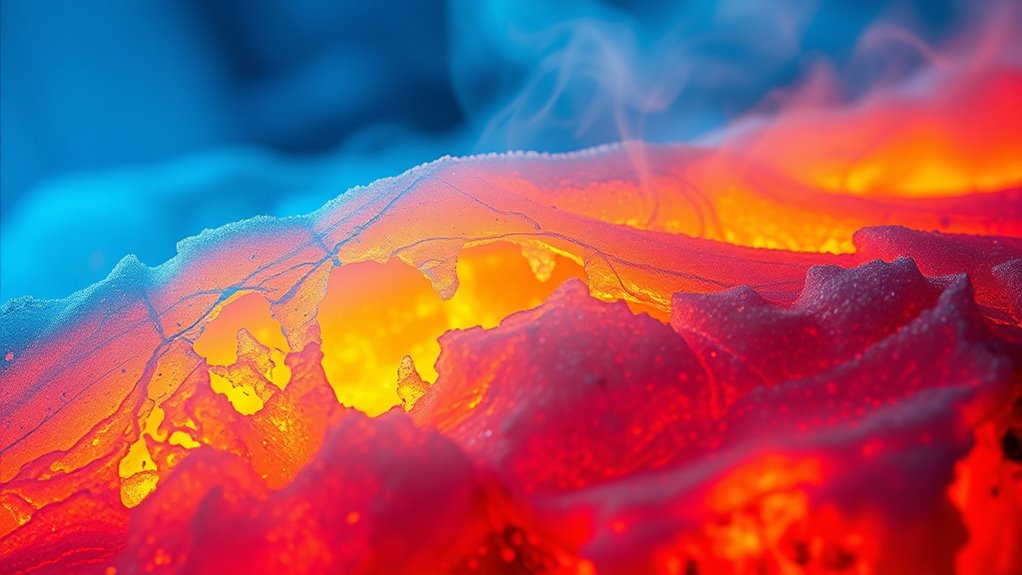Scientists have discovered a strange new state of matter called “half-ice, half-fire,” where icy and fiery properties coexist. This hybrid state forms through a quantum phase shift, which occurs at very low temperatures and involves atomic and electronic shifts. Its thermal behavior fluctuates dramatically, showing a delicate balance between insulating and conductive traits. If you continue exploring, you’ll uncover how this breakthrough can lead to exciting advances in quantum technologies and energy systems.
Key Takeaways
- Scientists have discovered a novel hybrid state of matter called “half-ice, half-fire,” featuring intertwined icy and fiery properties.
- This state arises from a quantum phase transition driven by atomic-scale quantum fluctuations.
- It exhibits unusual thermal conductivity, fluctuating dramatically based on local environment and quantum conditions.
- The formation involves precise tuning of conditions, allowing external control via magnetic fields or pressure.
- This discovery opens new avenues for engineering materials with customizable quantum and thermal properties.

Scientists have uncovered a striking new state of matter that they’re calling “half-ice, half-fire,” revealing a phenomenon where icy and fiery properties coexist in a single material. This discovery challenges traditional notions of phases of matter, opening the door to understanding how such an unusual state can exist. Central to this breakthrough is the concept of a quantum phase transition, a process that occurs at the atomic level when the material shifts from one quantum state to another under specific conditions. Unlike classical phase transitions, which happen due to temperature changes, quantum phase transitions happen at absolute zero and are driven by quantum fluctuations. This transition plays a vital role in stabilizing the unique properties observed in this new state.
As you explore this phenomenon, you’ll find that the material’s thermal conductivity behaves in a way that defies expectations. Typically, icy substances are good insulators, while fiery or hot materials conduct heat efficiently. In this “half-ice, half-fire” state, the material exhibits a thermal conductivity that fluctuates dramatically depending on the local environment and quantum state. This unusual thermal behavior indicates a delicate balance between insulating and conducting phases, which coexist at the quantum level. The material’s ability to switch between these properties suggests it could be manipulated for advanced thermal management, potentially leading to new technologies in electronics or energy storage. Moreover, this hybrid state exemplifies how quantum fluctuations can create entirely new phases of matter with extraordinary properties. Understanding these fluctuations is key to harnessing such novel states for practical applications.
The coexistence of contrasting properties in a single substance isn’t accidental; it results from finely tuned conditions where quantum fluctuations dominate. When the material undergoes a quantum phase transition, its electronic and atomic arrangements shift, resulting in a hybrid state. Here, icy and fiery characteristics aren’t just layered or mixed; they’re intertwined at the quantum scale, creating a stable yet remarkably adaptable phase. You might imagine this as a delicate dance, where the material dynamically responds to external stimuli, such as magnetic fields or pressure, toggling between states that resemble ice and fire simultaneously. This quantum control over material properties underscores the potential for engineering new states of matter with tailored functionalities. Additionally, the ability to precisely manipulate these phases could lead to breakthroughs in superconductivity and other quantum phenomena.
Furthermore, the ability to manipulate such states could pave the way for advances in quantum technologies, which rely on precise control of quantum phenomena. This discovery signifies more than just a scientific curiosity. It exemplifies how understanding quantum phase transitions can liberate new states of matter with extraordinary properties. The ability to control thermal conductivity at the quantum level hints at future applications, from quantum computing to innovative energy systems. As you delve deeper into this research, you’ll realize that the “half-ice, half-fire” state isn’t just a scientific novelty—it’s a glimpse into a future where matter can be engineered at the most fundamental level for unprecedented functionalities.
Frequently Asked Questions
How Does the “Half-Ice, Half-Fire” State Compare to Known Phases of Matter?
When you explore the “half-ice, half-fire” state, you’re looking at a unique phase that differs from traditional matter phases. Unlike typical solid, liquid, or gas, this state involves a phase shift driven by quantum phenomena, creating a hybrid condition. It challenges your understanding of matter by combining properties of both ice and fire, offering a glimpse into new quantum behaviors that don’t fit into known phase categories.
Can This New State Be Applied in Practical Technology?
Think of this new state as a bridge between ice and fire, symbolizing a unique energy transfer during phase shift. If harnessed, it could revolutionize technology by enabling more efficient energy management and innovative materials. While practical applications are still in early stages, understanding and controlling this state might lead to breakthroughs in energy storage, cooling systems, or even quantum devices, turning this fascinating discovery into real-world solutions.
What Tools or Instruments Were Crucial in Discovering This State?
You rely on advanced tools like spectroscopy techniques and cryogenic sensors to discover new states of matter. Spectroscopy helps you analyze the material’s properties at the atomic level, while cryogenic sensors allow you to cool samples to extremely low temperatures, revealing unique behaviors. These instruments are essential because they enable precise measurements and control, helping you identify and understand the fascinating “half-ice, half-fire” state in experimental settings.
Does This Discovery Suggest Other Unknown States of Matter Exist?
You might wonder if this discovery hints at other unknown states of matter. It’s quite possible, as quantum phenomena often reveal exotic materials with unique properties. Such findings suggest that the universe could hold many more surprises, encouraging you to explore further. This discovery opens doors for scientists to uncover even stranger states, expanding our understanding of matter’s behavior beyond traditional boundaries.
How Stable Is the “Half-Ice, Half-Fire” State Over Time?
Imagine a delicate dance between ice and fire, where the balance seems almost magical. You wonder about its thermal stability and phase longevity, and the truth is, it’s quite fleeting. This state exists only under precise conditions, and over time, it shifts, blending into more familiar forms. Its unique nature makes it inherently unstable, so you can expect it to last only moments before transforming, a brief glimpse of the extraordinary.
Conclusion
So, next time you feel like you’re stuck between two worlds, remember scientists just found something even stranger: “half-ice, half-fire.” It’s funny how nature can surprise us with states of matter we never imagined, making us realize that the universe’s mysteries are far from frozen or fiery—they’re both at once. Who knew that in the quest for understanding, you’d stumble upon a chill that burns and a heat that freezes? Truly, science keeps us on our toes.









